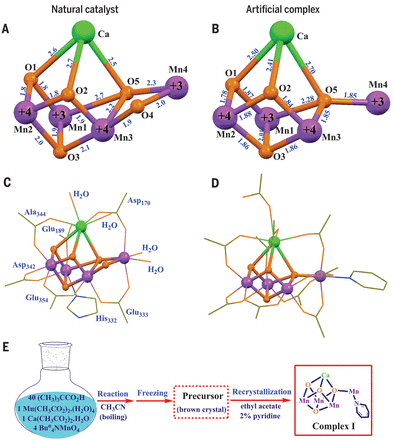Our official English website, www.x-mol.net, welcomes your
feedback! (Note: you will need to create a separate account there.)
A synthetic Mn4Ca-cluster mimicking the oxygen-evolving center of photosynthesis
Science ( IF 44.7 ) Pub Date : 2015-05-07 , DOI: 10.1126/science.aaa6550 Chunxi Zhang 1 , Changhui Chen 2 , Hongxing Dong 2 , Jian-Ren Shen 3 , Holger Dau 4 , Jingquan Zhao 1
Science ( IF 44.7 ) Pub Date : 2015-05-07 , DOI: 10.1126/science.aaa6550 Chunxi Zhang 1 , Changhui Chen 2 , Hongxing Dong 2 , Jian-Ren Shen 3 , Holger Dau 4 , Jingquan Zhao 1
Affiliation

|
Mimicking the oxygen evolution center Making a synthetic analog of plant photosynthesis is a key goal for exploiting solar energy and replacing fossil fuels. Zhang et al. synthesized a manganese-calcium cluster that looks and acts like the oxygen evolution center in photosystem II (see the Perspective by Sun). The mimic structurally resembles the biological complex, with the notable exception of bridging protein ligands and water-binding sites on a dangling Mn atom. Functionally, however, the cluster's metal center readily undergoes four redox transitions, which contribute to splitting water into oxygen. This and other synthetic mimics will pave the way for developing more efficient catalysts for artificial photosynthesis. Science, this issue p. 690; see also p. 635 A synthetic analog could help shed light on the molecular tools plants use to make oxygen. [Also see Perspective by Sun] Photosynthetic splitting of water into oxygen by plants, algae, and cyanobacteria is catalyzed by the oxygen-evolving center (OEC). Synthetic mimics of the OEC, which is composed of an asymmetric manganese-calcium-oxygen cluster bound to protein groups, may promote insight into the structural and chemical determinants of biological water oxidation and lead to development of superior catalysts for artificial photosynthesis. We synthesized a Mn4Ca-cluster similar to the native OEC in both the metal-oxygen core and the binding protein groups. Like the native OEC, the synthetic cluster can undergo four redox transitions and shows two magnetic resonance signals assignable to redox and structural isomerism. Comparison with previously synthesized Mn3CaO4-cubane clusters suggests that the fourth Mn ion determines redox potentials and magnetic properties of the native OEC.
中文翻译:

模拟光合作用氧气释放中心的合成 Mn4Ca 簇
模仿氧气演化中心制作植物光合作用的合成模拟物是开发太阳能和替代化石燃料的关键目标。张等人。合成了一个锰钙簇,它的外观和行为类似于光系统 II 中的氧气演化中心(参见 Sun 的透视图)。该模拟物在结构上类似于生物复合物,但显着的例外是在悬空的 Mn 原子上桥接蛋白质配体和水结合位点。然而,在功能上,簇的金属中心很容易经历四次氧化还原转变,这有助于将水分解为氧气。这种和其他合成模拟物将为开发更有效的人工光合作用催化剂铺平道路。科学,这个问题 p。690; 另见第。635 合成类似物可以帮助阐明植物用来制造氧气的分子工具。[另见 Sun Perspective] 植物、藻类和蓝藻将水光合作用分解为氧气是由氧气释放中心 (OEC) 催化的。OEC 的合成模拟物由与蛋白质基团结合的不对称锰-钙-氧簇组成,可以促进对生物水氧化的结构和化学决定因素的了解,并导致开发用于人工光合作用的优良催化剂。我们在金属氧核心和结合蛋白组中合成了类似于天然 OEC 的 Mn4Ca 簇。与天然 OEC 一样,合成簇可以经历四次氧化还原跃迁,并显示出两个可归因于氧化还原和结构异构的磁共振信号。
更新日期:2015-05-07
中文翻译:

模拟光合作用氧气释放中心的合成 Mn4Ca 簇
模仿氧气演化中心制作植物光合作用的合成模拟物是开发太阳能和替代化石燃料的关键目标。张等人。合成了一个锰钙簇,它的外观和行为类似于光系统 II 中的氧气演化中心(参见 Sun 的透视图)。该模拟物在结构上类似于生物复合物,但显着的例外是在悬空的 Mn 原子上桥接蛋白质配体和水结合位点。然而,在功能上,簇的金属中心很容易经历四次氧化还原转变,这有助于将水分解为氧气。这种和其他合成模拟物将为开发更有效的人工光合作用催化剂铺平道路。科学,这个问题 p。690; 另见第。635 合成类似物可以帮助阐明植物用来制造氧气的分子工具。[另见 Sun Perspective] 植物、藻类和蓝藻将水光合作用分解为氧气是由氧气释放中心 (OEC) 催化的。OEC 的合成模拟物由与蛋白质基团结合的不对称锰-钙-氧簇组成,可以促进对生物水氧化的结构和化学决定因素的了解,并导致开发用于人工光合作用的优良催化剂。我们在金属氧核心和结合蛋白组中合成了类似于天然 OEC 的 Mn4Ca 簇。与天然 OEC 一样,合成簇可以经历四次氧化还原跃迁,并显示出两个可归因于氧化还原和结构异构的磁共振信号。


















































 京公网安备 11010802027423号
京公网安备 11010802027423号